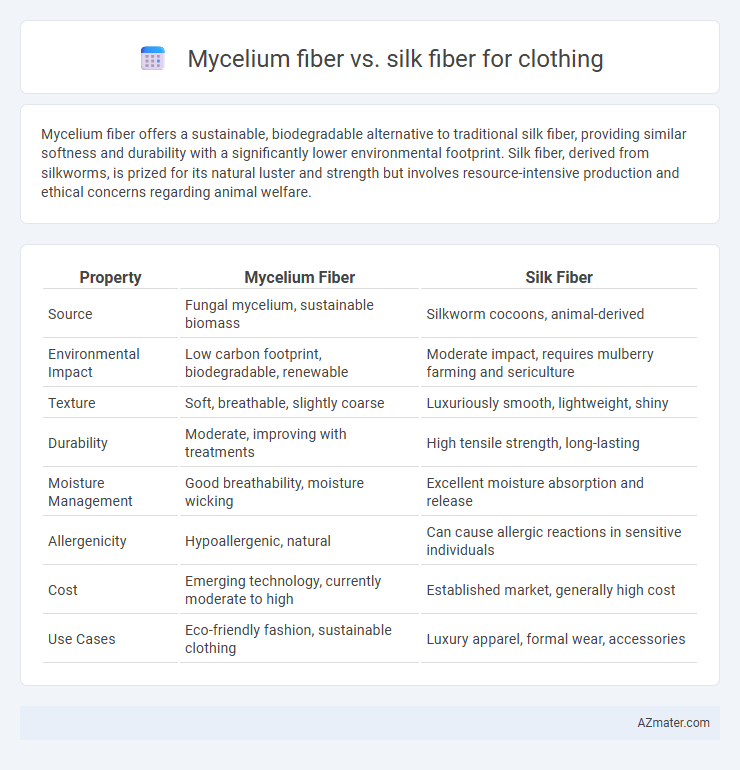Mycelium fiber offers a sustainable, biodegradable alternative to traditional silk fiber, providing similar softness and durability with a significantly lower environmental footprint. Silk fiber, derived from silkworms, is prized for its natural luster and strength but involves resource-intensive production and ethical concerns regarding animal welfare.
Table of Comparison
| Property | Mycelium Fiber | Silk Fiber |
|---|---|---|
| Source | Fungal mycelium, sustainable biomass | Silkworm cocoons, animal-derived |
| Environmental Impact | Low carbon footprint, biodegradable, renewable | Moderate impact, requires mulberry farming and sericulture |
| Texture | Soft, breathable, slightly coarse | Luxuriously smooth, lightweight, shiny |
| Durability | Moderate, improving with treatments | High tensile strength, long-lasting |
| Moisture Management | Good breathability, moisture wicking | Excellent moisture absorption and release |
| Allergenicity | Hypoallergenic, natural | Can cause allergic reactions in sensitive individuals |
| Cost | Emerging technology, currently moderate to high | Established market, generally high cost |
| Use Cases | Eco-friendly fashion, sustainable clothing | Luxury apparel, formal wear, accessories |
Introduction to Mycelium and Silk Fibers
Mycelium fiber, derived from the root structure of fungi, offers a sustainable and biodegradable alternative to traditional textile fibers with unique breathability and durability properties. Silk fiber, produced by silkworms, is prized for its natural sheen, smooth texture, and high tensile strength, making it a luxurious choice for high-end clothing. Both fibers exhibit distinct structural and functional characteristics that influence their suitability and performance in fashion applications.
Origins and Production Processes
Mycelium fiber is derived from the root structure of fungi, cultivated through a sustainable process that involves growing fungal networks on agricultural waste, resulting in a biodegradable, eco-friendly material. Silk fiber originates from the cocoons of the silkworm, harvested through a labor-intensive process where silkworms spin natural protein fibers, which are then reeled and spun into threads. While mycelium fiber production emphasizes low environmental impact and renewable resources, silk production relies on traditional sericulture with a significant water and resource footprint.
Material Properties: Strength and Durability
Mycelium fiber exhibits impressive tensile strength and resilience, making it highly durable for clothing applications, often comparable to or exceeding silk fiber's strength. Unlike silk, which is protein-based and delicate to abrasion and environmental factors, mycelium fibers offer enhanced resistance to wear, moisture, and UV exposure. The natural elasticity and robust cellular structure of mycelium contribute to its superior longevity and sustainable performance in textile manufacturing.
Sustainability and Environmental Impact
Mycelium fiber, derived from fungal mycelium, offers a biodegradable and low-impact alternative to traditional silk fiber, which relies on silkworm cultivation and often involves significant water usage and chemical treatments. Unlike silk production, mycelium fiber cultivation requires less land, water, and energy, significantly reducing carbon emissions and waste. The sustainable cultivation of mycelium fiber supports circular fashion initiatives by enabling compostable clothing materials that minimize environmental harm compared to the resource-intensive and less eco-friendly silk industry.
Comfort and Wearability
Mycelium fiber offers exceptional breathability and moisture-wicking properties, making it highly comfortable for extended wear, while its natural elasticity enhances flexibility and fit. Silk fiber is renowned for its smooth texture and temperature-regulating capabilities, providing a luxurious feel and adaptability in both warm and cool climates. Compared to silk, mycelium fiber is more sustainable and hypoallergenic, contributing to improved wearability for sensitive skin.
Aesthetic Qualities and Versatility
Mycelium fiber offers a unique matte texture with natural color variations, lending garments an earthy, organic aesthetic that appeals to sustainable fashion enthusiasts. Silk fiber provides a luxurious sheen and smooth, lightweight feel, prized for its elegant drape and high-end appearance in formal and casual wear. While mycelium excels in eco-friendly, breathable, and biodegradable clothing, silk remains versatile in its ability to be dyed vibrantly and tailored for diverse garment styles, from delicate scarves to structured suits.
Cost and Accessibility
Mycelium fiber offers a more sustainable and cost-effective alternative to silk fiber, as it can be produced using inexpensive agricultural waste and requires less water and land resources. Silk fiber, derived from silkworms, involves labor-intensive harvesting and higher production costs, making it less accessible for mass-market clothing. Mycelium fiber's scalability and lower environmental footprint contribute to its growing availability and affordability in the textile industry.
Applications in Fashion and Apparel
Mycelium fiber, derived from fungal mycelium, offers a sustainable and biodegradable alternative to traditional silk fiber, which is harvested from silkworm cocoons. Mycelium's unique texture and flexibility enable its use in innovative fashion applications, including eco-friendly garments and accessories, while silk's natural luster and strength remain favored for luxury apparel and high-end textiles. Fashion designers increasingly incorporate mycelium fiber to reduce environmental impact, complementing silk's established role in breathable, lightweight, and smooth fabric production.
Consumer Perception and Market Trends
Mycelium fiber, derived from mushroom roots, is gaining traction in sustainable fashion due to its biodegradability and eco-friendly production, appealing to environmentally conscious consumers. Silk fiber, known for its luxurious texture and durability, maintains strong market demand, especially in premium apparel and traditional fashion sectors. Market trends indicate increasing consumer interest in mycelium fiber as brands emphasize circular economy practices, although silk remains dominant for high-end clothing due to its established heritage and tactile qualities.
Future Prospects: Innovation and Development
Mycelium fiber, derived from mushroom roots, offers sustainable and biodegradable alternatives to traditional silk fiber, which is extracted from silkworms and requires intensive resource use. Innovations in mycelium fiber production focus on enhancing durability, texture, and scalability, positioning it as a promising material for ethical fashion and eco-friendly textiles. Continued development in biotechnology and material science aims to improve mycelium fiber's performance, potentially revolutionizing the clothing industry with renewable and cruelty-free fabrics.

Infographic: Mycelium fiber vs Silk fiber for Clothing
 azmater.com
azmater.com